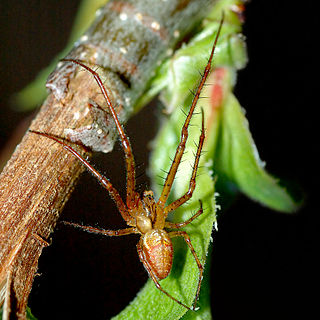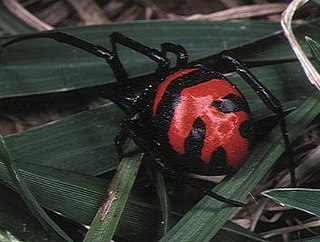
Long-jawed orb weavers or long jawed spiders (Tetragnathidae) are a family of araneomorph spiders first described by Anton Menge in 1866. They have elongated bodies, legs, and chelicerae, and build small orb webs with an open hub with few, wide-set radii and spirals with no signal line or retreat. Some species are often found in long vegetation near water.

Tord Tamerlan Teodor Thorell was a Swedish arachnologist.

Chrysilla is a genus of jumping spiders that was first described by Tamerlan Thorell in 1887. Several species formerly placed here were transferred to Phintella, and vice versa. Females are 3 to 4 millimetres long, and males are 4 to 9 millimetres long. The genus is Persian, derived from the Greek Χρύσιλλα.

Epocilla is a genus of jumping spiders that was first described by Tamerlan Thorell in 1887. The name comes from Ἐπόκιλλος (Epocillus), a soldier of Alexander the Great.

Telamonia is a genus of jumping spiders that was first described by Tamerlan Thorell in 1887. They are colorful spiders, with patterns that vary considerably between sexes and species. Two longitudinal stripes along the abdomen are common, and the carapace is often colored. They have a slender opisthosoma and long legs.

Uloborus is a spider genus in the family Uloboridae with 72 described species. Most species occur in the tropics and subtropics, with only few species in northern America and Europe.
Pacullidae is a family of araneomorph spiders first described by Eugène Simon in 1894. It was merged into Tetrablemmidae in 1958, then raised back to family status after a large phylogenetic study in 2017.

Tetragnatha is a genus of long-jawed orb-weavers found all over the world. It was first described by Pierre André Latreille in 1804, and it contains hundreds of species. Most occur in the tropics and subtropics, and many can run over water. They are commonly called stretch spiders in reference to their elongated body form and their ability to hide on blades of grass or similar elongated substrates by stretching their front legs forward and the others behind them. The name Tetragnatha is derived from Greek, tetra- a numerical prefix referring to four and gnatha meaning "jaw". Evolution to cursorial behavior occurred long ago in a few different species, the most studied being those found on the Hawaiian islands. One of the biggest and most common species is T. extensa, which has a holarctic distribution. It can be found near lakes, river banks or swamps. Large numbers of individuals can often be found in reeds, tall grass, and around minor trees and shrubs.

Latrodectus elegans is a species of black widow spider, found in South Asia, Southeast Asia and East Asia. It was first collected by the Swedish arachnologist Tamerlan Thorell in the Karen Hills in Myanmar, but is also found in Thailand, India, Nepal, Vietnam, China and Japan. As of July 2022, the World Spider Catalog only lists India, Nepal, Myanmar, China and Japan. This species has only been recorded in India and Nepal since 2012, and Indochina in 2015, which is thought to reflect historical under-surveying of arachnids in this region.

Cyrtarachne is a genus of orb-weaver spiders first described by Tamerlan Thorell in 1868.
Oedignatha is a genus of Asian spiders first described by Tamerlan Thorell in 1881 as a genus of corinnid sac spiders, and moved to Liocranidae in 2014.

Poltys is a genus of orb-weaver spiders first described by C. L. Koch in 1843. Many species are cryptic and are known to masquerade as leaves and twigs during the day, and build an orb web at night to capture prey. The shape of the abdomen which often gives the impression of a rough and broken branch can vary among individuals within a species. The web is eaten up before dawn and reconstructed after dusk.
Anaxibia is a genus of cribellate araneomorph spiders in the family Dictynidae, and was first described by Tamerlan Thorell in 1898.
Janula is a genus of comb-footed spiders that was first described by Embrik Strand in 1932. It is a senior synonym of Monetoculus.
Perania is a genus of Asian araneomorph spiders in the family Pacullidae that was first described by Tamerlan Thorell in 1890. It is considered a senior synonym of Mirania.
Deione is a genus of Asian orb-weaver spiders first described by Tamerlan Thorell in 1898.
Talthybia is a genus of Asian orb-weaver spiders containing the single species, Talthybia depressa. It was first described by Tamerlan Thorell in 1898, and has only been found in China and Myanmar.
Zelotes captator is a species of Southeast Asian ground spider. It was first described by Tamerlan Thorell in 1887, and has only been found in Myanmar. In 2022, it was moved from the monotypic genus Aracus to the genus Zelotes.

Hygropoda is a genus of nursery web spiders that was first described by Tamerlan Thorell in 1894.

Althepus is a genus of spiders in the family Psilodercidae. It was first described in 1898 by Tamerlan Thorell. As of 2019, it contains 60 species, all from Asia.











